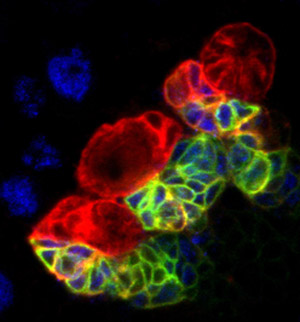The Zhu Lab
Drs. Li and Xie in the Zhu lab published a paper that reports a novel mechanism of Notch-mediated maintenance of neural stem cells in developing brains in the July 15 issue of Development - a leading primary research journal covering the field of developmental biology. Li X, Xie Y, Zhu S. Notch maintains Drosophila type II neuroblasts by suppressing expression of the Fez transcription factor Earmuff. Development. 2016 Jul 15;143(14):2511-21.
 The neural stem cells (NSCs) are pluripotent ancestral cells that produce all nerve cells in the brain. One big challenge that the NSCs face during brain development is to maintain their own population while they undergo repetitive divisions to produce a large number of nerve cells. NSCs meet this challenge by producing a new NSC to self-renew while dividing to generate a more specialized cell. It has been well documented that a cell membrane protein called Notch is critical for maintaining NSCs. Removing Notch from NSCs could lead to elimination of NSCs and brain development defects. In contrast, overactivation of Notch could result in unrestricted proliferation of NSCs and brain tumor formation. However, how Notch maintains NSCs was not well understood. In this NIH-funded study, Dr. Li and her colleagues investigated this problem using the developing fruit fly brain as a model. In the fly brains, a type of NSCs called type II neuroblasts (large red cells), which produce neurons by generating transient amplifying intermediate neural progenitor cells (INPs) (small green cells) like human NSCs, also critically depends on Notch for their maintenance. Dr. Li et al. discovered that Notch maintained type II neuroblasts by preventing a gene called earmuff, which is normally expressed in INPs to promote differentiation, from being activated early in the neuroblasts. This work not only elucidates a novel mechanism of the maintenance of NSCs in developing brains, but also provides an important insight into brain tumor formation.
The neural stem cells (NSCs) are pluripotent ancestral cells that produce all nerve cells in the brain. One big challenge that the NSCs face during brain development is to maintain their own population while they undergo repetitive divisions to produce a large number of nerve cells. NSCs meet this challenge by producing a new NSC to self-renew while dividing to generate a more specialized cell. It has been well documented that a cell membrane protein called Notch is critical for maintaining NSCs. Removing Notch from NSCs could lead to elimination of NSCs and brain development defects. In contrast, overactivation of Notch could result in unrestricted proliferation of NSCs and brain tumor formation. However, how Notch maintains NSCs was not well understood. In this NIH-funded study, Dr. Li and her colleagues investigated this problem using the developing fruit fly brain as a model. In the fly brains, a type of NSCs called type II neuroblasts (large red cells), which produce neurons by generating transient amplifying intermediate neural progenitor cells (INPs) (small green cells) like human NSCs, also critically depends on Notch for their maintenance. Dr. Li et al. discovered that Notch maintained type II neuroblasts by preventing a gene called earmuff, which is normally expressed in INPs to promote differentiation, from being activated early in the neuroblasts. This work not only elucidates a novel mechanism of the maintenance of NSCs in developing brains, but also provides an important insight into brain tumor formation.
